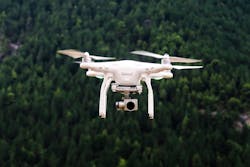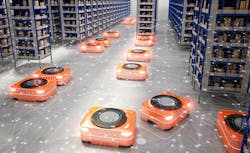Wireless Networking Unlocks It
The Industrial Internet of Things (IIoT) is rapidly increasing the number of devices, equipment, and vehicles connected. It’s also bringing new potential clients to you for ways to ensure their automation is supported by low-latency, highly reliable networks that can improve their companies’ productivity and save them money.
Transmitting and receiving data from autonomous or remotely controlled assets can allow businesses to analyze real-time telemetry and situational data. These insights enable more significant levels of autonomy that can help critical industrial sectors, such as warehousing, manufacturing, ports, and heavy construction. Automated assets, whether drones, vessels, robots, or machinery, are a game-changer for companies looking to grow and harness the power of IIoT securely.
Traditional Wi-Fi networks used in industrial settings typically rely on fixed infrastructure. Maintaining connectivity with automated and autonomous systems can prove challenging as they move around common obstacles.
While the benefits of adopting automation can prove immeasurable, they depend on unfailing network connectivity. Without a thoroughly reliable, fault-proof network infrastructure, this data-based technology can be at risk of interruption. Depending on what purpose it serves, it can prove counter-intuitive for efficiency.
A wireless network that is fully mobile can empower drones and robotics with continuous on-the-go connectivity for machine-to-machine (M2M) communications. Wireless nodes can be deployed directly on all mobile assets, allowing for a robust and resilient network. In the near future, autonomous systems and robotics will become operational necessities and their ability to move and communicate is entirely network dependent. By taking advantage of the most optimal wireless mesh network, businesses can ensure its connectivity is reliable and effective.
Keeping Data Safe and Secure
With the rise of Artificial Intelligence (AI) and the IIoT, integrated and intelligent systems must incorporate new assets into a network to deal with autonomous security threats. The stakes are more mission-critical than ever with automation's overall power and efficiency evolving for both businesses and hackers. That’s why operators should provide autonomous networks that can be segmented into multiple virtual networks. These will support cryptographic options that can securely safeguard data.
Whether your clients are warehouses or ports, their productivity and accuracy processes require continuous mobile connectivity. If the network stops working momentarily, it negates any efficiency gains. That’s why traditional Wi-Fi networks used in industrial settings typically rely on fixed infrastructure.
That can be problematic, however. Consider warehouses as an example. Clients need consistent, high-speed connectivity to use their automated and autonomous systems. Oftentimes, connectivity is interrupted as workers move around common obstacles like metal racks and heavy equipment. Workers may also use handheld scanners and RFID wands while they move about doing their jobs. As a result, they often deal with interference issues. Unfortunately, costly infrastructure is then needed to overcome those interference issues and keep devices, personnel, and mobile robots connected.
With an intelligent or self-optimizing network, interference and additional infrastructure needs are non-issues. Fully wireless, self-optimizing, and mobile coverage can provide resilient M2M connectivity across warehouses, ports, and other industrial settings.
Autonomy Begs for More
The main benefit of autonomous systems is the natural reduction of tedious, time-consuming processes. Autonomy can also help keep personnel out of hazardous environments and eradicate the need for them to do dirty, dull, and dangerous tasks. This is a safety benefit for businesses and serves as a cost-effective benefit in the long term.
By enabling situational awareness for operators, automating hazardous processes, and transmitting data in real-time, autonomous robotics systems are transforming the overall productivity of daily operations. A robot can only perform to its maximum potential when it is supported by a high-performing, wireless network to transmit real-time data across long distances and through remote areas.
That’s why autonomous networks must be fully mobile and equipped with wireless nodes that can be deployed virtually anywhere–meaning that any land, air, and sea robot can become a network element with lightweight communications attached. This connectivity can also enable M2M communications between robots, machines, and drones to orchestrate actions.
A low-latency mesh network is a good choice for these applications because it can hold multiple connections simultaneously and work peer-to-peer to form robust and redundant links between assets from various sectors.
Drone Surveillance
Consider the case for your customers who create large-scale events. In these situations, protecting the public is the top priority. Today, automated technology is at the center of mass communication and sophisticated surveillance. To have an effective security plan in place for any large-scale event, you must guarantee a fail-proof wireless network to ensure a covert and undetectable operation throughout the event.
A robot can only perform to its maximum potential when it is supported by a high performing, wireless network to transmit real-time data across long distances and through remote areas.
Crowded events such as demonstrations and street festivals pose many challenges for security personnel, requiring additional coverage and internal communication resources. Extra security can leverage a wireless mesh network that can offer an extensive range of network coverage. An example of how this can be utilized is through the deployment of drones. In a single mission, the wireless nodes can be distributed on hundreds of state-of-the-art drones with built-in AI that enables internal communications to be sent and received anywhere in the vicinity. This allows personnel to alert rapid response teams and the police if they are needed. Of course, a low latency, future-proof, and fully mobile network is paramount to leveraging automation for mission-critical surveillance. One option operators and their clients should evaluate for this type of mobile network is Rajant Corporation’s Kinetic Mesh® technology.
Network Autonomy = Productivity Gains
Harnessing autonomy can unleash an organization’s full potential but only with the right wireless network. By learning the subtle but important differences between emerging use cases, operators can support their clients who must evolve their companies’ productivity and efficacy. Added mobility and autonomy can genuinely transform how your clients can prosper in the IIoT age.
ABOUT THE AUTHOR
Chris Wall is Sales Director, Rajant Corporation. He has vast experience in industrial networking, specializing in indoor automation, robotics, public safety, and O&G. For more information, please email [email protected] or visit https://rajant.com. You can also follow them on Twitter @RajantCorp and LinkedIn: rajant-corporation.
About the Author
Chris Wall
Sales Director, Rajant Corporation
Chris Wall is Sales Director, Rajant Corporation. He has vast experience in industrial networking, specializing in indoor automation, robotics, public safety, and O&G. For more information, please email [email protected] or visit https://rajant.com. You can also follow them on Twitter @RajantCorp and LinkedIn: Rajant Corporation.


